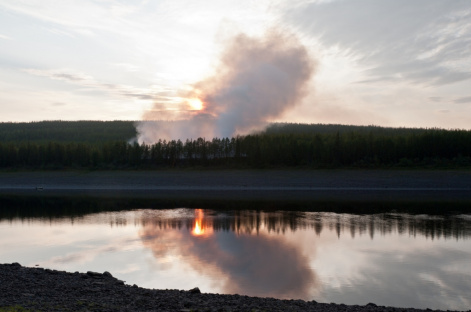Climate change and fires in the northern taiga will affect the quality of water in the rivers of the Arctic Ocean basin
2 June 2020 г.

Each year, the Arctic rivers carry about 35 million tons of organic matter into the Arctic Ocean. The contribution of one of the great rivers of the world, the Yenisei, to this stream is five million tons of organic matter and a little less than one hundred thousand tons of nitrogen. These compounds in the river flow mainly come from forest soils in river basins. In recent years, due to climate change and anthropogenic activities in the territory of northern Eurasia, the frequency and intensity of fires has increased. The concomitant degradation of permafrost affects the ability of forest soils to retain organic and inorganic substances. At the same time, studies of how the catchment areas of the Arctic zone respond to the occurring changes are still quite rare and often contradictory.
A team of scientists from North America and Russia presented the results of many years of research on the chemical composition of small rivers in Evenkia, where larch forests grow in permafrost. For the study, catchment areas were chosen, which large fires occurred at different time periods, from one to more than a hundred years ago. After forest fires the concentration of inorganic forms of nitrogen were found to increase in water streams as well as a significant decrease in dissolved organic carbon was observed, which was accompanied by changes in its molecular composition. In the latter case, high-precision equipment made it possible to identify more than 17,000 organic compounds of various composition in the river flow and, accordingly, to estimate the qualitative changes in organic matter in watercourses after fires.
The scientists performed such studies of the rivers of the vast area of the Central Siberian Plateau for the first time. An important part of the research was experiments on the application of various types of mineral fertilizers to elucidate the biological response of aquatic ecosystems to forest fires. Scientists found out that bacterial communities in the rivers switch from the absorption of the organic form of nitrogen to the nitrate form. At the same time, it was the lack of available organic substrate that limited the ability of bacteria to absorb nitrogen.
The study revealed that about half a century is required to restore the concentration and initial molecular composition of dissolved organic carbon to prefire values. During this period, in the larch forests, an organic layer is again formed on the soil surface, which is the main source of dissolved organic matter in the rivers of Siberia. The nitrate form of nitrogen reacts in a different way to the fire effects. Its concentration increases over about ten years due to aeration and soil drainage, as well as due to the death of vegetation which absorbs nitrogen in undisturbed forests. Thus, as forest vegetation is restored, nitrate levels in streams decrease to pre-fire values.
A decrease in the removal of dissolved organic matter and an increase in the flow of nitrogen into the rivers flowing into the Arctic Ocean, which is predicted due to an increase in the frequency of fires in northern forests and permafrost degradation, will lead to changes in water quality. Reducing the amount of organic matter in water from the view point of human industrial activity is good, since water in rivers in these latitudes is often characterized by “organic” pollution and does not meet quality requirements. The effects of increased nitrate concentrations are more complex. On the one hand, the observed nitrogen concentrations indicate a deterioration in this parameter of water quality. On the other hand, an excess of nitrogen can lead to an increase in the productivity of water bodies.
“In general, such changes in the chemical composition of river waters in the northern areas are fraught with restructuring in communities of aquatic organisms and require further research. On a global scale, the changes are also affecting the Arctic Ocean, which is now receiving more fresh water than before, ” says one of the authors of the article, Candidate of Biological Sciences, head of the laboratory of biogeochemical cycles in forest ecosystems at the V.N. Sukachev Institute of Forest SB RAS, Anatoly Prokushkin.
The study was supported by a grant from the Russian Foundation for Basic Research No. 18–05–60203-Arctic.
Share:
